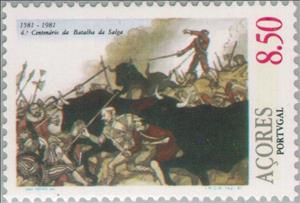Stamp: 1581-1981, 4 Centuries to the Battle of Salga 8.50 (Azores 1981)
1581-1981, 4 Centuries to the Battle of Salga 8.50 (Azores 1981)
28 August (Azores ) within release 4th Centuries to the Battle of Salga goes into circulation Stamp 1581-1981, 4 Centuries to the Battle of Salga 8.50 face value 8.50 Portuguese escudo
| Stamp 1581-1981, 4 Centuries to the Battle of Salga 8.50 in catalogues | |
|---|---|
| Michel: | Mi:PT-AZ 343 |
| Afinsa-Mundifil: | Afi:PT 1528 |
Stamp is square format.
4th Centenary of the Battle of SalgaAlso in the issue 4th Centuries to the Battle of Salga:
- Stamp - 1581-1981, 4 Centuries to the Battle of Salga 8.50 face value 8.50;
- Stamp - 1581-1981, 4 Centuries to the Battle of Salga 33.50 face value 33.50;
Stamp 1581-1981, 4 Centuries to the Battle of Salga 8.50 it reflects the thematic directions:
Mammals are any vertebrates within the class Mammalia (/məˈmeɪli.ə/ from Latin mamma "breast"), a clade of endothermic amniotes distinguished from reptiles (including birds) by the possession of a neocortex (a region of the brain), hair, three middle ear bones and mammary glands. All female mammals nurse their young with milk, secreted from the mammary glands. Mammals include the largest animals on the planet, the great whales. The basic body type is a terrestrial quadruped, but some mammals are adapted for life at sea, in the air, in trees, underground or on two legs. The largest group of mammals, the placentals, have a placenta, which enables the feeding of the fetus during gestation. Mammals range in size from the 30–40 mm (1.2–1.6 in) bumblebee bat to the 30-meter (98 ft) blue whale. With the exception of the five species of monotreme (egg-laying mammals), all modern mammals give birth to live young. Most mammals, including the six most species-rich orders, belong to the placental group. The largest orders are the rodents, bats and Soricomorpha (shrews and allies). The next three biggest orders, depending on the biological classification scheme used, are the Primates (apes and monkeys), the Cetartiodactyla (whales and even-toed ungulates), and the Carnivora (cats, dogs, seals, and allies).
Cattle (Bos taurus) are large, domesticated, bovid ungulates widely kept as livestock. They are prominent modern members of the subfamily Bovinae and the most widespread species of the genus Bos. Mature female cattle are called cows and mature male cattle are bulls. Young female cattle are called heifers, young male cattle are oxen or bullocks, and castrated male cattle are known as steers.
Animals are multicellular, eukaryotic organisms of the kingdom Animalia (also called Metazoa). All animals are motile, meaning they can move spontaneously and independently, at some point in their lives. Their body plan eventually becomes fixed as they develop, although some undergo a process of metamorphosis later on in their lives. All animals are heterotrophs: they must ingest other organisms or their products for sustenance.
An anniversary is the date on which an event took place or an institution was founded in a previous year, and may also refer to the commemoration or celebration of that event. For example, the first event is the initial occurrence or, if planned, the inaugural of the event. One year later would be the first anniversary of that event. The word was first used for Catholic feasts to commemorate saints. Most countries celebrate national anniversaries, typically called national days. These could be the date of independence of the nation or the adoption of a new constitution or form of government. The important dates in a sitting monarch's reign may also be commemorated, an event often referred to as a "Jubilee".




